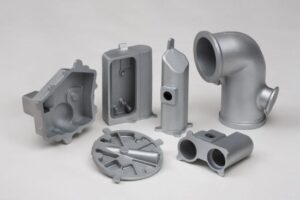The history of precision casting, also known as casting with wax models, dates back thousands of years. Initially, precision casting was employed to create idols, jewelry, and ornaments. From the outset of using this casting method, there were numerous challenges in manufacturing various engineering tools and producing parts with high dimensional accuracy, until more precise casting techniques were developed. This method is so ancient that it can be considered the primary casting technique. In precision casting, both the model and the mold are single-use, meaning they cannot be reused.
What is precision casting?
Precision casting, also known as investment casting or casting with wax models, minimizes material waste, energy consumption, and the need for post-molding machining. This method allows for the production of highly complex parts under optimal conditions and with great precision. In this process, a pattern of the various components of the final piece is created from wax and assembled together. The complete wax pattern is then encased in a ceramic, plaster, or plastic material to form a shell around it. Precision casting involves constructing a refractory mold by covering the wax models and subsequently transferring molten metal into this mold, where it solidifies to form the final piece. The primary advantage of this technique is its ability to cast metals with high melting temperatures that cannot be molded using traditional plaster or metal methods.
The precision casting process using wax is a very precise method for producing metal parts with complex geometry from any type of alloy. Today, many metal alloys such as plain carbon steel, alloy steel, stainless steel, aluminum, bronze alloys, gray cast iron and ductile cast iron are cast by this method. The most important advantage of this method is making parts that have a high melting temperature and cannot be molded in plaster or metal. Some users mistakenly search casting as precision casting, but actually they mean precision casting. In fine casting, the wax pattern is melted in a furnace and removed, and the metal is poured into the shell to create the casting.
The steps of manufacturing parts by precision casting method
In general, fine casting can be done in two ways:
- direct casting; in which wax plays the main role and its use is mandatory.
- indirect casting; To do that, we are not required to use wax.
In the following article, we will examine precision casting by indirect method.
First step: making the main pattern
In this step, a basic pattern is created from wax, clay, wood or plastic. In recent years and with the advancement of technology, the production of patterns using three-dimensional (3D) printing is used, which are used with high-resolution patterns.
The second step: making a precise casting mold
First, the main template is made. If the master pattern is made of steel, the mold can be cast directly using a lower melting point metal with the master pattern. Also, plastic molds also have the possibility of casting with the original pattern. In the direct method, the main mold is directly machined and used without making a pattern.
The third step: producing wax patterns
Contrary to the name of these patterns, they are not necessarily made of wax, because in addition to wax, materials such as mercury and plastic may also be used in their construction. Wax patterns are made by two methods: in the first method, some wax is poured into the mold so that the inner surface of the mold is covered with wax. In the second method, they fill the entire mold with wax and wait until it cools down and turns into a solid state.
Step 4: Assembling and making the assembly bush
Different wax patterns can be mounted and assembled into one large pattern to be cast in a batch. In this situation, the patterns are attached to a wax jar to create a pattern cluster or tree. This shrub-like pattern helps us produce parts in one batch.
The fifth step: using precision casting materials
The ceramic mold undergoes a series of steps—coating, plating, and hardening—to achieve the desired thickness. During the precision casting coating process, the pattern is immersed in a slurry of refractory materials to create a uniform surface coating. To preserve the intricate details of the mold, fine materials, known as primary coating, are utilized. In the plating step, coarse ceramic particles are applied manually by dipping the patterns into a molten substrate, followed by a hardening phase that allows the coating to cure. Additionally, the mold must dry, which typically takes between 16 to 48 hours. These steps are repeated until the desired thickness is attained.
Sixth step: Dewaxing
At this stage, the ceramic shell with the wax pattern inside is placed upside down in the furnace so that the wax pattern melts and the ceramic shell remains.
Seventh step: Preheating the molds
At this stage, the ceramic molds are heated to a temperature of 900 to 1100 degrees Celsius. This heating makes molds clean of any moisture and wax residues. The advantage of doing this step is that you can use the same hot molds for casting. By doing this, the duration of solidification of the melt increases, as a result of which, the dimensional accuracy increases and the mechanical properties improve.
The eighth stage: unloading
Gravity, air pressure and other forces play an important role in pouring molten materials into the mold, that’s why the mold is placed in a tub full of sand and then the molten materials are poured into it.
The last step: stripping
To remove the precision casting part, the ceramic shell can be removed with the help of a hammer or vibration. The channel is recycled and used again after the part is separated. Usually, at the end, the cast product is cleaned by turning or grinding.

